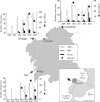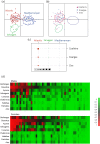Colony Foundation in an Oceanic Seabird
- PMID: 26909694
- PMCID: PMC4766187
- DOI: 10.1371/journal.pone.0147222
Colony Foundation in an Oceanic Seabird
Abstract
Seabirds are colonial vertebrates that despite their great potential for long-range dispersal and colonization are reluctant to establish in novel locations, often recruiting close to their natal colony. The foundation of colonies is therefore a rare event in most seabird species and little is known about the colonization process in this group. The Cory's shearwater (Calonectris diomedea) is a pelagic seabird that has recently established three new colonies in Galicia (NE Atlantic) thus expanding its distribution range 500 km northwards. This study aimed to describe the establishment and early progress of the new Galician populations and to determine the genetic and morphometric characteristics of the individuals participating in these foundation events. Using 10 microsatellite loci, we tested the predictions supported by different seabird colonization models. Possibly three groups of non-breeders, adding up to around 200 birds, started visiting the Galician colonies in the mid 2000's and some of them eventually laid eggs and reproduced, thus establishing new breeding colonies. The Galician populations showed a high genetic diversity and a frequency of private alleles similar to or even higher than some of the large historical populations. Most individuals were assigned to several Atlantic populations and a few (if any) to Mediterranean colonies. Our study suggests that a large and admixed population is settling in Galicia, in agreement with predictions from island metapopulation models of colonization. Multiple source colonies imply that some birds colonizing Galicia were dispersing from very distant colonies (> 1500 km). Long-distance colonizations undertaken by relatively large and admixed groups of colonizers can help to explain the low levels of genetic structure over vast areas that are characteristic of most oceanic seabird species.
Conflict of interest statement
Figures







References
-
- Kokko H, López-Sepulcre A. From individual dispersal to species ranges: perspectives for a changing world. Science 2006; 3135788: 789–791. - PubMed
-
- Parmesan C. Ecological and evolutionary responses to recent climate change. Annual Review of Ecology, Evolution, and Systematics 2006; 637–669.
-
- Levins R. Some demographic and genetic consequences of environmental heterogeneity for biological control. Bulletin of the Entomological Society of America 1969; 153: 237–240.
-
- Hanski I. Metapopulation dynamics. Nature 1998; 396: 41–49.
-
- Nichols RA, Hewitt GM. The genetic consequences of long distance dispersal during colonization. Heredity 1994; 72: 312–317.
Publication types
MeSH terms
LinkOut - more resources
Full Text Sources
Other Literature Sources

